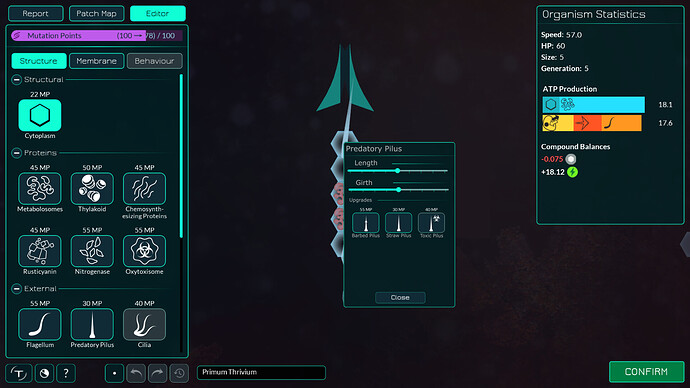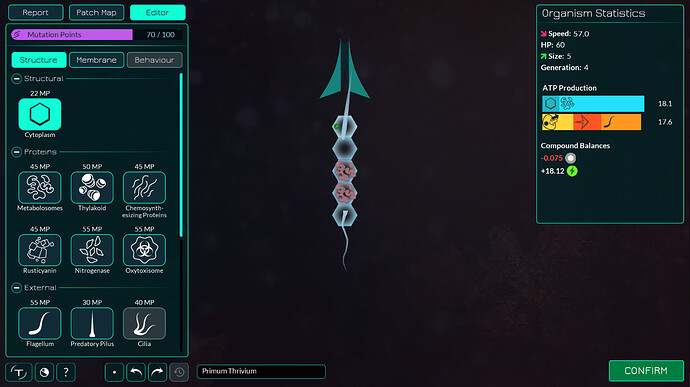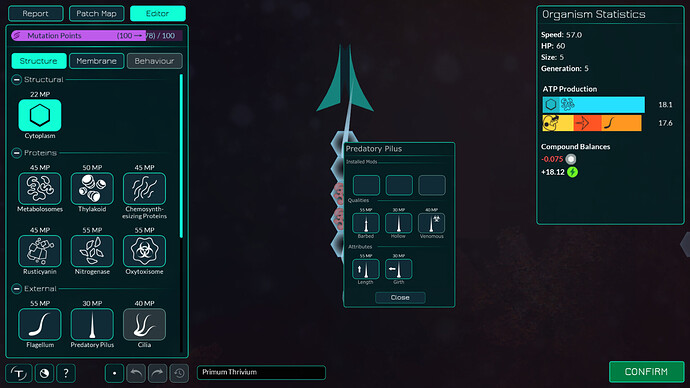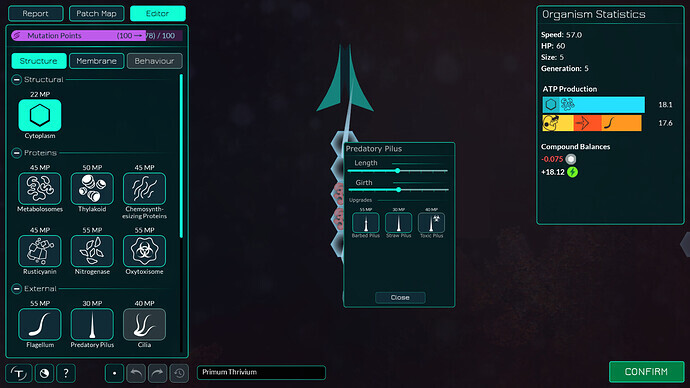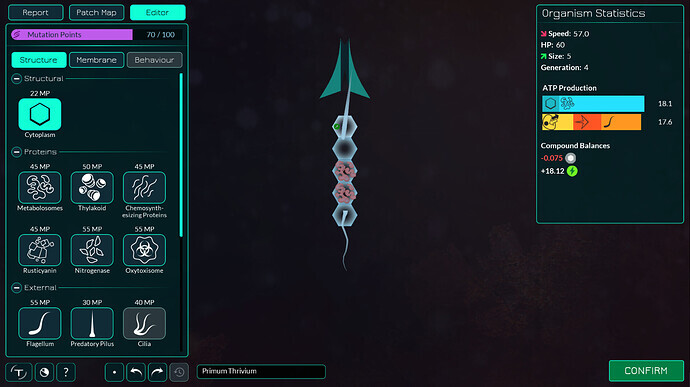We are approaching a point in development where upgrades might be more relevant, so here are some proposed organelle upgrades to ensure that we have material. Much of it is based on Buckly’s previous post above, and I simply included more organelles and slightly tweaked some existing concepts, which absolutely is open to comment and reversion.
I would like to spend some time in the near future on related concepts, such as refining the enzyme concept and defining gameplay themes across the prokaryotic and eukaryotic parts of the stage, so I would like to see if there is some consensus on these ideas.
Input would also be appreciated on how to sleekly demonstrate some important stats surrounding your organism, such as environmental tolerance ranges.
GENERAL NOTES - Perhaps right-clicking on a placed part only applies modifications to that specific part, but right-clicking on the part button in the editor GUI applies modifications to all future instances of that part placed.
I brought up in discussion with Buckly the idea of traditional upgrades - in other words, upgrades which outright buff a part’s process efficiency to make it better, with only the slight cost of increased ammonia/phosphate costs - and he said that in his opinion, it would be better to stick with specializations and tradeoffs. While I do think that flat upgrades should eventually be considered, as there are certain leaps in evolution in the multicellular stage which would be really difficult to represent through small-scale specialization, I do think it is a very good idea to focus much more on upgrades that come with tradeoffs as opposed to upgrades which outright make a part better; such is the epitome of evolution, and would make for the most dynamic approach to gameplay.
Metabolosomes
Anaerobic/Aerobic Toggle - A switch between an anaerobic and aerobic metabolic breakdown of glucose. Anaerobic metabolosomes produce less ATP, but are more versatile in habitable ranges. Aerobic metabolosomes produce more ATP and provide tolerance to oxygen, but are dependent on the presence of oxygen and will lose anaerobic function. (Variant; will need to consult with theory to see exactly how best to approach this)
Antitoxicity - Metabolosome assists with the metabolizing of toxins at the cost of less ATP generation. Four less ATP while providing .01 toxic resistance. (Slider)
In the previous concept, antitoxicity was a perk of mitochondria, relegated to being eukaryotic. I suggest that it might better to offer anti-toxicity to prokaryotic metabolosomes since toxins are really important amongst prokaryotes. If we want the antitoxicity slider to instead be a special “power” for eukaryotes to distinguish themselves from prokaryotes however, I’m all ears.
The anaerobic/aerobic toggle will be important in the arrival of free oxygen that will happen across most early worlds when oxygenic photosynthesis appears.
Mitochondria
Antitoxicity - Mitochondrium assists with the metabolizing of toxins at the cost of less ATP generation. 10 less ATP while providing .02 toxic resistance. (Slider)
Thermogenesis - Mitochondrium will consume extra glucose, providing heat to resist the cold in return. Will consume 0.1 more glucose (0.063 glucose at 21% oxygen) and lowers temperature tolerance by 1C (EX: Temperature range of 21C-30C becomes 20C-29C) (Slider)
Hydrogenosome - The mitochondrium will become anaerobic, allowing a wider range of habitability. However, ATP production will decrease by 50%. (Variant) Hydrogenosome - an overview | ScienceDirect Topics
Note that I suggest thermogenesis to be a unique eukaryotic capability in contrast to the previous post. Once again however, I’m not particularly pushing for this, it’s just a suggestion we can figure out through conversation.
Thylakoids
Oxygenic - Photosynthesis will now split water to produce oxygen, increasing the efficiency of photosynthesis but necessitating aerobic tolerance. 8.9B: Anoxygenic Photosynthetic Bacteria - Biology LibreTexts.
Red Pigments - Increases photosynthetic efficiency in low-lit conditions, but decreases photosynthetic efficiency in normally-lit conditions. (Slider)
Brown Pigments - Increases tolerance to cold temperatures, but decreases tolerance to higher temperatures. (Slider)
A brief google search I did seemed to indicate that red pigments were found in deep-sea photosynthetic organisms (seaweeds and other red algae) and brown pigments were found in photosynthetic organisms closer to the poles, so I wanted to reflect this to more accurately reflect life as we know it by adding red pigments and attaching Buckly’s idea to them.
The first suggestion reflects a bit of evolutionary history, where it took a while for photosynthesis to begin splitting water, and thus, producing free oxygen. It adds a cool layer I think, but it obviously can be cut if we decide that is too much detail.
Chloroplasts
Red Pigments - Increases photosynthetic efficiency in low-lit conditions, but reduces photosynthetic efficiency in normally-lit conditions. (Slider)
Brown Pigments - Increases tolerance to cold temperatures, but decreases tolerance to higher temperatures. (Slider)
Flattened - Thylakoids within the chloroplast are flattened and more streamline, reducing mass and increasing speed but decreasing glucose generation by 10% (Slider?)
Notice the lack of an Oxygenic option, which is supposed to reflect eukaryotic photosynthesis on Earth. The option can be included here as well if you guys think it is warranted.
Chemosynthesizing Proteins
Increased Tolerance to Heat - Increases tolerance to heat by .5 Celsius and decreases tolerance to cold temperatures by .5. Increases total mass by .25(?). (Slider)
Sulfur Granules - Produces sulfur granules, increasing toxin resistance by 5%. Produces 10% less glucose.(Slider)
Sulfur granules have been observed in some sulfur-respiring organisms, but I took a bit of liberty in gamifying them. Open to suggestions and comments.
Chemoplasts
Increased Tolerance to Heat - Increases tolerance to heat by 1 Celsius and decreases tolerance to cold temperatures by 1 Celsius. Increases total mass by .25 (Slider)
Sulfur Granules - Produces sulfur granules, increasing toxin resistance by 10%. Produces 10% less glucose. (Slider)
Rusticyanin
Mineralization - Creates mineralized granules which add +2 Health, but reduces ATP production by 10%. (source)
https://journals.asm.org/doi/10.1128/AEM.01492-06
Similar to the sulfur granules of the above organelles, iron granules appear in certain iron-respiring cells but their exact purpose isn’t well known, so I took some liberties in gamifying them. Again, open to comments.
Nitrogenase
Denitrification - Instead of passively generating ammonia, the nitrogenase will speed up cell processes by up to 5% depending on the amount of ammonia within the cell(?). Releases Nitrogen. Exclusively anaerobic.
I’m not 100% sure if this is solid and I just spat it out, but I want to hear thoughts. The nitrogen cycle is a very prominent component in life as we know it, both in the niches which cells take and the ecosphere’s overall health, so it feels a bit weird just having a single part of it in. I get a similar feeling with hydrogen sulfide and chemosynthesis, but of course, we should be limiting our scope in some ways.
Nitrogen-Fixating Plastid
Not so sure about this one.
Chemoreceptor
Cell-Tracing - Allows the tracking of specific cell species instead of compound clouds. (Variant)
Pilus
See Above Post
Would like to note there is potential for a lock-and-key method here, with different lengths and girths being more effective against different membranes, but we should be wary with just throwing a lot of concepts into the lock-and-key method and look at the stage holistically to make sure we aren’t overwhelming players.
Flagellum
Length - A shorter flagella decreases sprint speed but decreases the rate at which stamina depletes. A longer flagella increases sprint speed but increases the rate at which stamina depletes.
Note to the Graphics Team - I personally don’t think that there is a need for a lot of wildly different models to be created for most upgrades. I would think that most changes would take the shape of small variations. If an artist would like to spend some time discussing this, don’t be afraid to reach out or just start conceptualizing.
